When it comes to learning a foreign language, it is always the case that what is given little attention by the native speaker is the hardest nut to crack for the foreign learner. The native speaker of Japanese, for example, wouldn’t pay much attention to his/her use of particles like wa and ga when speaking (as well as writing), while for someone who learns Japanese as a foreign language Japanese particles are always troublesome and confusing.
In the pronunciation of English, weak forms of grammatical words are considered to be a stepping stone for the learner aspiring to acquire a nativelike accent. The learner is therefore told to learn to be able to pronounce to write and for all as tə ˈraɪt and fər ˈɔːl, rather than tuː ˈraɪt and fɔːr ˈɔːl. This is very important in order to acquire the rhythm of a stress-timed language such as English. A weak form occurs as a result of the speaker paying very little attention to the grammatical word in question and therefore trying to quickly move to the semantically important content word that follows it: in uttering to write the speaker naturally places more emphasis on write than on to because the former is supposed to be semantically more important. Weak forms are, as it were, a product of the speaker’s unconsciousness.
Here is the difficulty.
I have long been teaching my students the importance of weak forms, but I sometimes doubt if this approach of mine is ever appropriate. That I emphasize the importance of weak forms means that my students get more conscious of and consequently put more emphasis on the pronunciation of grammatical words. Very often this brings about a bizarre consequence: grammatical words tend to get stressed even though they are pronounced in their weak forms. So, for example, to write is pronounced ˈtə raɪt, or sometimes even ˈta raɪt.
Please have a look at my main blog!

I really like the way you talk about weak forms as a product of the speaker's unconsciousness.
ReplyDelete